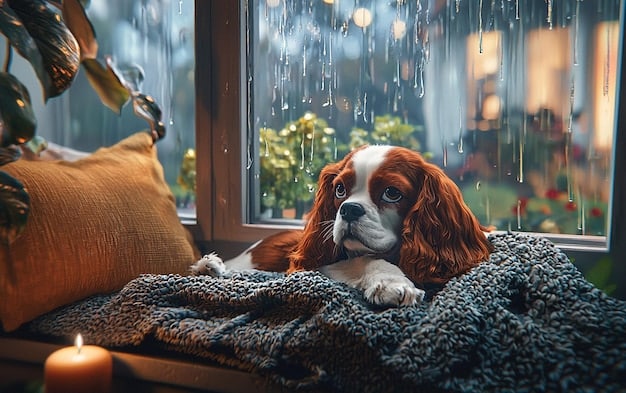Fear of Thunder: Calming Techniques to Reduce Your Dog’s Anxiety

Fear of thunder is a common anxiety in dogs, but employing calming techniques such as creating a safe space, using white noise, and desensitization methods can significantly reduce their anxiety by up to 60%.
Is your furry friend terrified of thunderstorms? You’re not alone. Fear of Thunder: Calming Techniques to Reduce Your Dog’s Anxiety by 60%, let’s explore effective ways to help your dog cope with their anxiety and reclaim those stormy nights.
Understanding Thunder Phobia in Dogs
Thunder phobia in dogs is a prevalent issue, often leading to significant distress during thunderstorms. It’s crucial to understand the triggers and manifestations of this phobia to effectively implement calming strategies.
Many factors contribute to a dog’s fear of thunder, including genetics, past traumatic experiences, and learned behavior. Recognizing these underlying causes can help you tailor your approach to manage your dog’s anxiety.
Common Symptoms of Thunder Phobia
Dogs exhibit various symptoms when experiencing thunder phobia. Identifying these signs early can help you intervene and provide comfort.
- Excessive panting or drooling
- Pacing or restlessness
- Hiding or seeking shelter
- Trembling or shaking
Why Dogs Fear Thunder: The Science Behind It
Several scientific reasons explain why dogs are particularly sensitive to thunderstorms. Understanding these factors can help you empathize with your dog’s fear and take appropriate action.
- Dogs have a heightened sense of hearing, making thunder seem much louder.
- Changes in barometric pressure can also trigger anxiety.
- Static electricity buildup may cause discomfort.
In conclusion, understanding the science behind thunder phobia and recognizing common symptoms are essential first steps in helping your dog cope with their anxiety. By addressing these factors, you can create a more comfortable and safe environment during storms.

Creating a Safe Haven for Your Dog
Providing a safe haven is one of the most effective ways to reduce your dog’s anxiety during thunderstorms. This involves creating a secure and comfortable space where your dog can retreat when feeling scared.
A safe haven offers a sense of control and security, allowing your dog to cope with the storm more effectively. This space should be easily accessible and associated with positive experiences.
Setting Up the Perfect Den
Creating a comfortable and secure den can make a significant difference in your dog’s anxiety levels. Follow these steps to set up an ideal retreat.
- Choose a quiet, interior room or closet.
- Provide a comfortable bed or blanket.
- Include familiar toys and treats.
Training Your Dog to Use Their Safe Space
It’s important to train your dog to associate the safe haven with positive experiences. This will encourage them to seek it out during thunderstorms.
- Introduce the space gradually, using positive reinforcement.
- Offer treats and praise when your dog enters the den.
- Never force your dog into the space.
In conclusion, creating and training your dog to use a safe haven is a crucial step in managing their thunder phobia. By providing a secure and comfortable retreat, you can significantly reduce their anxiety during storms. This safe space becomes a reliable source of comfort, helping your dog feel more secure and less stressed.
Using Calming Aids and Products
Various calming aids and products can help alleviate your dog’s anxiety during thunderstorms. These tools range from pheromone diffusers to specialized clothing designed to reduce stress.
When selecting calming aids, it’s essential to consider your dog’s individual needs and preferences. What works for one dog may not work for another, so experimentation might be necessary.
ThunderShirts and Anxiety Wraps
ThunderShirts and anxiety wraps apply gentle, constant pressure to your dog’s torso, which can have a calming effect. This method is similar to swaddling a baby and can help reduce anxiety symptoms.
These products are readily available and easy to use, making them a popular choice for managing thunder phobia in dogs. Many owners report noticeable improvements in their dog’s behavior during storms.
Pheromone Diffusers and Sprays
Pheromone diffusers and sprays release synthetic versions of the calming pheromones produced by female dogs while nursing puppies. These pheromones can help reduce anxiety and promote a sense of security.
- Diffusers are plugged into an electrical outlet.
- Sprays can be applied to bedding or in the safe haven area.
- These products are particularly effective for dogs with generalized anxiety.
Natural Supplements and Medications
Some natural supplements and medications can help reduce anxiety in dogs. Always consult with your veterinarian before introducing any new supplements or medications to your dog’s routine.
- Melatonin is a natural hormone that can promote relaxation.
- L-Theanine is an amino acid that can reduce stress.
- Prescription medications are available for more severe cases of anxiety.

In conclusion, calming aids and products can be valuable tools in managing your dog’s thunder phobia. Whether it’s a ThunderShirt, pheromone diffuser, or natural supplement, these aids can provide added comfort and reduce anxiety during thunderstorms. Remember to consult with your vet to determine the best options for your dog’s specific needs.
Desensitization and Counter-Conditioning Techniques
Desensitization and counter-conditioning are behavioral modification techniques that can help your dog overcome their fear of thunder. These methods involve gradually exposing your dog to thunderstorm-related stimuli while associating them with positive experiences.
These techniques require patience and consistency but can be highly effective in reducing your dog’s anxiety over time. It’s essential to proceed at your dog’s pace and avoid overwhelming them.
Playing Thunder Sounds at Low Volume
Start by playing recordings of thunder at a very low volume while your dog is engaged in a positive activity, such as eating, playing, or being petted. Gradually increase the volume as your dog becomes more comfortable.
This gradual exposure helps your dog become desensitized to the sound of thunder. The key is to keep the volume low enough that your dog remains relaxed and does not exhibit signs of anxiety.
Associating Thunder with Positive Experiences
Pair the sound of thunder with positive experiences, such as giving your dog their favorite treats or engaging in a fun game. This helps create a positive association with thunderstorms.
- Use high-value treats that your dog only gets during these sessions.
- Keep the sessions short and positive.
- End each session on a positive note.
Creating a Calm Environment During Training
Ensure that the training environment is calm and relaxed. Avoid any distractions or stressors that could exacerbate your dog’s anxiety. A quiet, familiar setting can help your dog feel more secure.
Consistency is crucial when using desensitization and counter-conditioning techniques. Regular training sessions can significantly reduce your dog’s thunder phobia over time, making thunderstorms less stressful for both of you.”
The Power of Distraction and Play
Distraction and play can be powerful tools for managing your dog’s anxiety during thunderstorms. Engaging your dog in activities they enjoy can help redirect their attention away from the storm and create positive associations.
By channeling their energy into fun and engaging activities, you can reduce their overall anxiety levels and make thunderstorms more manageable. Distraction techniques work best when introduced early in the storm.
Interactive Games and Toys
Interactive games and toys can provide a mental and physical outlet for your dog during thunderstorms. These activities can help keep them occupied and reduce their focus on the storm.
- Puzzle toys require your dog to solve a problem to get a treat.
- Fetch or tug-of-war can provide physical exercise.
- Chew toys can offer comfort and reduce anxiety.
Engaging Your Dog in Training Exercises
Use training exercises to distract your dog from the thunder. Reviewing basic commands or introducing new tricks can provide a mental challenge and redirect their attention.
- Practice commands such as “sit,” “stay,” and “come.”
- Introduce new tricks to keep your dog mentally stimulated.
- Reward your dog with treats and praise for their efforts.
The Importance of a Calm Demeanor
Your demeanor plays a significant role in how your dog perceives the situation. Remaining calm and composed can reassure your dog and reduce their anxiety. Dogs are highly sensitive to their owners’ emotions, so maintaining a positive attitude can be incredibly beneficial.
In conclusion, distraction and play offer effective ways to manage your dog’s anxiety during thunderstorms. By engaging them in enjoyable activities and maintaining a calm demeanor, you can create a more positive experience and reduce their fear over time.
When to Seek Professional Help
While many strategies can help manage your dog’s thunder phobia, some dogs may require professional intervention. Recognizing when to seek help from a veterinarian or certified dog trainer is crucial for their well-being.
If your dog’s anxiety is severe, causing significant distress or impacting their quality of life, it’s time to consult with a professional. They can provide tailored advice and develop a comprehensive treatment plan.
Consulting with Your Veterinarian
Your veterinarian can assess your dog’s overall health and rule out any underlying medical conditions contributing to their anxiety. They can also recommend suitable medications or supplements to help manage their symptoms.
A veternarian will also be able to explore any medical conditions that cause the anxiety.
Working with a Certified Dog Trainer or Behaviorist
A certified dog trainer or behaviorist can help you implement effective behavioral modification techniques, such as desensitization and counter-conditioning. They can provide personalized guidance and support to help your dog overcome their fear of thunder.
- Seek out trainers with experience in anxiety management.
- Ensure the trainer uses positive reinforcement methods.
- Follow the trainer’s recommendations consistently.
Medication Options for Severe Anxiety
In severe cases of thunder phobia, medication may be necessary to manage your dog’s anxiety. Your veterinarian can prescribe medications that help reduce anxiety symptoms and improve your dog’s quality of life.
- Anti-anxiety medications can provide relief during thunderstorms.
- Work closely with your vet to monitor your dog’s response to medication.
- Medication should be used in conjunction with behavioral modification techniques.
In conclusion, knowing when to seek professional help is essential for managing your dog’s thunder phobia. Whether it’s consulting with your veterinarian, working with a certified dog trainer, or considering medication options, seeking professional intervention can provide the necessary support to help your dog live a happier, less anxious life.
| Key Point | Brief Description |
|---|---|
| 🏠 Safe Haven | Create a secure space for your dog to retreat to during storms. |
| 👕 Calming Aids | Use ThunderShirts or pheromone diffusers to reduce anxiety. |
| 🎵 Desensitization | Gradually expose your dog to thunder sounds at low volumes. |
| 🎾 Distraction | Engage your dog in play or training to divert their attention. |
Frequently Asked Questions
▼
Dogs have a heightened sense of hearing, making thunder seem much louder. They may also be sensitive to changes in barometric pressure and static electricity.
▼
Choose a quiet, interior room or closet. Provide a comfortable bed, familiar toys, and treats to make it a secure retreat for storms.
▼
Its effectiveness is subjective. While many dog owners report success, it may not work for every dog. Monitor your dog’s behavior and adjust the approach accordingly.
▼
Seek help if the fear seems severe, causing distress or impacting their quality of life, it’s time to consult with a vet or certified trainer.
▼
Yes, desensitization can be effective when done gradually and consistently. Pair thunder noises with positive reinforcements to help your dog relax during storms.
Conclusion
Managing a dog’s fear of thunder requires patience, understanding, and a combination of techniques. From creating safe havens and using calming aids to employing desensitization strategies and seeking professional help, there are many ways to reduce your dog’s anxiety and improve their well-being during thunderstorms. By implementing these methods, you can help your furry friend feel more secure and less stressed, making stormy nights more manageable for both of you.





